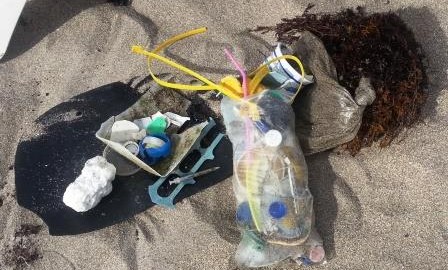
Every day, the ocean serves up a chance for us to change our ways.
That dawned on me when I was walking on the beach in south Florida and noticed, glinting from the sand, the corner of a clear plastic bag. Picking it up, it snapped in the wind and I saw it was still intact. After that, I couldn’t help but use it to collect other stuff left in the wake of the tide: bottle caps and straws, spoons and forks, hair clips and cup lids, and many, many plastic scraps.
That’s the thing about plastic: it never really breaks down. As I wrote after Superstorm Sandy, the problem afflicts fresh water, too. Bacteria and other micro-organisms naturally degrade things like banana peels, egg shells and other natural, organic matter. But machine-made plastics are petrochemical polymers that don’t degrade. They only become smaller and smaller bits of themselves.
Now that so much plastic has accidentally flown into, been tossed or dumped in the water, great masses of it float in areas just beneath the surface of the world’s oceans. The pieces are just small enough for animals to eat – making them sick, wreaking havoc on their immune systems or killing them outright. On Midway Atoll, for instance, a third of all Laysan Albatross chicks die after eating plastic fed to them by their parents.
Humans are also part of the plastics food chain. Jellyfish who ingest plastic are eaten by larger fish which often end up as our dinner.
Just-tossed plastics cause other damage. This bag is knotted into a pile of sea weed just the way it strangles sea turtles.
Leaves of washed-up sargassum weed were coated in a mesh-like material that didn’t look or feel natural.
This is a block of soap or some type of chemical that was being actively nibbled and scraped by a flock of seagulls, sand-pipers and other shore birds.
(By the way, I enjoyed looking up animal and plant names in the beautiful, easy-to-read guide, Florida’s Living Beaches: A Guide for the Curious Beachcomber by Blair and Dawn Witherington.)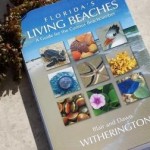
So, once or twice each day, the tides give us a do-over. If you’re lucky, a straw just like yours that was snatched by the wind will come back to you. But tread carefully as you collect. There could be sharp glass down there, too.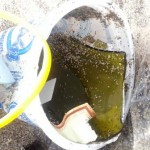
It seems to me that beach-front hotels could offer beach-combing for tidal leftovers as a feel-good “eco-activity.” Method, the bio-degradable soap-maker, re-uses ocean plastic in some of its bottles. Be sure to check out the great info-graphic and videos on their website.
Some ways we can help, according to The Florida Oceanographic Institute (plus a couple of my favorite tips):
- Buy a re-usable bottle and shop with re-usable bags
- If you forget your re-usable bag, ask for paper instead of plastic
- When you have a fast-food beverage, try to skip the lid and straw
- Ask restaurants to supply paper cups instead of plastic or styrofoam
- Pick up plastics wherever you roam
If you do anything, be proud of yourself because what you’re doing matters. It’s just like “The Starfish Story” I reprint here by Loren Eisley, courtesy of Starrbrite.com.
One day a man was walking along the beach when he noticed
a boy picking something up and gently throwing it into the ocean.
Approaching the boy, he asked, “What are you doing?”
The youth replied, “Throwing starfish back into the ocean.
The surf is up and the tide is going out. If I don’t throw them back, they’ll die.”
“Son,” the man said, “don’t you realize there are miles and miles of beach and hundreds of starfish? You can’t make a difference!”
After listening politely, the boy bent down, picked up another starfish,
and threw it back into the surf. Then, smiling at the man, he said,
“I made a difference for that one.”
Embracing nature is one important way to be your most durable. To learn more about how to do that as you live in harmony with your technology, I invite you to check out the tips and tricks in How To Be a Durable Human: Revive and Thrive in the Digital Age Through the Power of Self-Design.
For more Durable Human posts, news, and freebies, sign up here .
Hope you also join my circle on Google+.

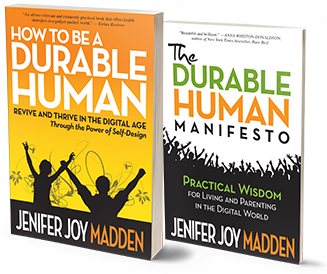
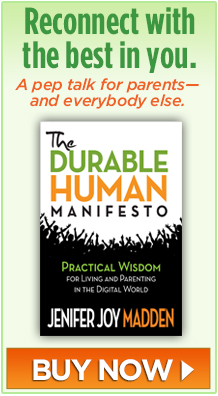
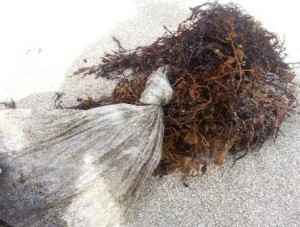
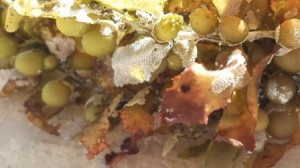
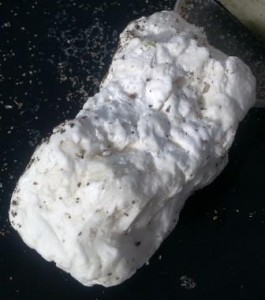

I was on Hutchinson Island last December and saw a LOT of plastic bottles and various other HUMAN LITTER—It was very sad and disgusting. My friend and I picked up a lot walking the beach in the AM.
THANKS FOR THE WORK YOU DO AND FOR EDUCATING PEOPLE ABOUT THIS ISSUE!!!
So glad to have a kindred spirit! There did seem to be improvement this year, but glad to know that you are out there being VIGILANT while I’m stuck in the cold north! : ) Thanks very much for taking the time to write.